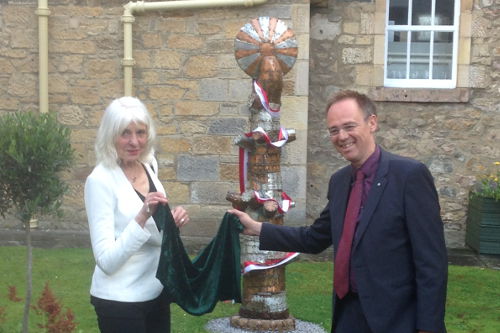Monday September 4th 2017

A tribute to an “extraordinary” sculptor who survived a concentration camp and wartime prison has been unveiled in his adopted home of Midlothian.
Zigfrids (Zigi) Sapietis escaped the horrors of war in his native Latvia – including a spell in a prison cell full of dead bodies and ‘living skeletons’ – to settle in Newbattle, near Dalkeith.
He renovated a derelict cottage to create a home studio where he lived and worked until his death, aged 90, in 2014.
Today, Zigi’s widow Paula unveiled one of his works, Tree of Life, in the courtyard at Newbattle Abbey College, which held a special place in her late husband’s heart.
“Zigi loved to walk among the beautiful trees at Newbattle – he connected with the woods; they were a very special place for him,” said Paula, 75. “He was allowed to collect fallen trees from Newbattle to use in his work and many pieces were crafted from wood from the college grounds.”
Paula continued: “When I discussed the idea of putting one of Zigi’s sculptures in the college, I chose it very carefully. I wanted it to be safe and well cared-for; it is part of Zigi’s soul.
“Tree of Life combined his true passions – nature, education and creativity. Zigi believed unlocking our creativity was at the very heart of freedom. He experienced some dreadful things in his early life in Latvia but he was not bitter; he was determined to turn his experiences into something positive, creative and special.”
Alex Hamilton, an artist and friend of Zigi for 40 years, said his work and his legacy was extremely important. “He was an exceptional artist who channelled terrible times into his art,” he said.
Honorary Consul for Latvia in Edinburgh and Scotland, John McGregor, who organised the event, said: “It was a privilege to have met Zigi, a great man whose presence commanded attention wherever and whenever you met him. It has been very rewarding to see the positive reaction to his works being exhibited in Scotland and Latvia. The unveiling marks another step towards ensuring that Zigi’s legacy can be enjoyed by all.”
Dr Alasdair Allan, Minister for International Development and Europe, who unveiled the sculpture with Paula Sapietis, described Zigi as an extraordinary man and artist. He revealed that the last census showed there were more than 4700 people born in Latvia living in Scotland and around 250 Latvian students.
Ann Southwood, Principal of Newbattle Abbey College, said: “Zigi was a great lover and supporter of the college and it is wonderful to have this lasting tribute to his life and work. We are very grateful to Paula, who continues to visit the college regularly and sings in our choir, for gifting this magnificent work to us.”
Zigi’s children from his first marriage, Una and Julian, could not attend, but in a message Julian said his dad would be “very proud” and recalled him finding raw material in the Newbattle grounds: “With the kind permission of the warden, many pieces of dead tree trunk or root ball were discovered by dad in the woods. That was the easy part. I remember as a small child with Una and my mother Shirley having to help drag some huge pieces back.
“Getting to the big bridge over the river was always a huge relief as then dad could get his trailer close and drive it home from there, often enlisting neighbours and friends to help.
“Once home, dad would chisel away at it outside removing all the rot and unwanted wood before bringing it into the studio for finishing, as long as it would fit in the doorway. Many weeks would be spent, sometimes working until 2am to create the finished piece.”
Zigi was also an art teacher at Portobello High School for 20 years, and an unofficial teacher to anyone who dropped into his home. “For people looking for artistic inspiration, he was a master,” said Paula, who still lives in the Newbattle cottage, surrounded by Zigi’s sculptures, ceramics and paintings as well as a huge collection of art books and equipment. His studio is still very much as it was, crammed full of his work, equipment, photographs and much more – all catalogued meticulously.
The cottage garden, where Zigi planted more than 200 trees, is home to some larger, more dramatic works, including Siberian Crosses and Souls of the Garden.
As a teenager, Zigi was imprisoned for hoisting the Latvian flag by the Gestapo following the Germans’ wartime invasion of Latvia, “He was caught between the Russians and the Germans, fighting for freedom and the traditions of his country,” said Paula. “He was imprisoned, beaten and very badly injured.
“He was later moved to a concentration camp and only the kindness of a German officer saved his life by helping him escape on a submarine,” said Paula. “That took him to Denmark and he lives there for seven years before coming to Scotland in 1952 to stay with a cousin in Edinburgh – and then to Newbattle.”
Some of Zigi’s work has been shipped to Latvia to be displayed there and Paula and Zigi’s friends in the art world are considering how to preserve his artistic and personal legacy.
Tweet Share on Facebook